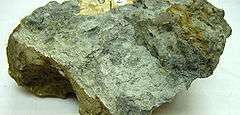Scorodite
| Scorodite | |
|---|---|
|
Scorodite, Gold Hill, Utah | |
| General | |
| Category | Arsenate minerals |
| Formula (repeating unit) | FeAsO4·2H2O |
| Strunz classification | 8.CD.10 |
| Crystal system | Orthorhombic |
| Crystal class |
Dipyramidal (mmm) H-M symbol: (2/m 2/m 2/m) |
| Space group | Pcab |
| Unit cell |
a = 8.937 Å, b = 10.278 Å c = 9.996 Å; Z = 8 |
| Identification | |
| Color | Green, blue-green, grey, grayish-green, blue, yellow-brown, nearly colorless, violet |
| Fracture | Sub-Conchoidal |
| Mohs scale hardness | 3.5-4 |
| Luster | Sub-Adamantine, Vitreous, Resinous |
| Streak | Greenish-White |
| Diaphaneity | Translucent |
| Density | measured: 3.27 g/cm3 calculated: 3.276 g/cm3 |
| Optical properties | Biaxial (+) |
| Pleochroism | Weak |
| 2V angle | Measured: 40° to 75° Calculated: 46° to 80° |
| Dispersion | relatively strong r > v |
| References | [1] |
Scorodite is a common hydrated iron arsenate mineral, with the chemical formula FeAsO4·2H2O. It is found in hydrothermal deposits and as a secondary mineral in gossans worldwide. Scorodite weathers to limonite.
Scorodite was discovered in the Schwarzenberg, Saxony district, Erzgebirge, Saxony, Germany. Named from the Greek Scorodion, "garlicky". When heated it smells of garlic, which gives it the name.
References
- ↑ http://www.mindat.org/min-3595.html Mindat data
- Palache, C., H. Berman, and C. Frondel (1951) Dana’s system of mineralogy, (7th edition), v. II, pp. 763–767
- Webmineral data
- Mineral Data Publishing
| Wikimedia Commons has media related to Scorodite. |
This article is issued from Wikipedia - version of the 11/23/2016. The text is available under the Creative Commons Attribution/Share Alike but additional terms may apply for the media files.
